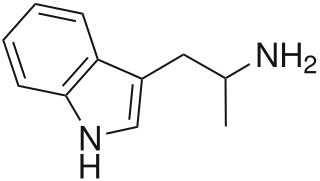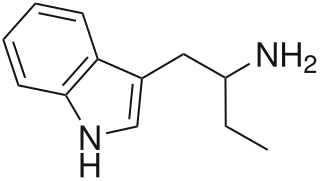
Psychedelics are a subclass of hallucinogenic drugs whose primary effect is to trigger non-ordinary mental states and an apparent expansion of consciousness. Also referred to as classic hallucinogens or serotonergic hallucinogens, the term psychedelic is sometimes used more broadly to include various types of hallucinogens, such as those which are atypical or adjacent to psychedelia like salvia and MDMA, respectively. This article makes use of the narrower classical definition of psychedelics. Classic psychedelics generally cause specific psychological, visual, and auditory changes, and oftentimes a substantially altered state of consciousness. They have had the largest influence on science and culture, and include mescaline, LSD, psilocybin, and DMT.

α-Methyltryptamine is a psychedelic, stimulant, and entactogen drug of the tryptamine class. It was originally developed as an antidepressant by chemists at Upjohn in the 1960s, and was used briefly as an antidepressant in Russia under the trade name Indopan before being discontinued.

2C-T-2 is a psychedelic and entactogenic phenethylamine of the 2C family. It was first synthesized in 1981 by Alexander Shulgin, and rated by him as one of the "magical half-dozen" most important psychedelic phenethylamine compounds. The drug has structural and pharmacodynamic properties similar to those of 2C-T-7.

5-MeO-DMT (5-methoxy-N,N-dimethyltryptamine) or O-methyl-bufotenin is a psychedelic of the tryptamine class. It is found in a wide variety of plant species, and also is secreted by the glands of at least one toad species, the Colorado River toad. Like its close relatives DMT and bufotenin (5-HO-DMT), it has been used as an entheogen in South America. Slang terms include Five-methoxy, the power, bufo, and toad venom.

α-Ethyltryptamine, also known as etryptamine, is a psychedelic, stimulant, and entactogenic drug of the tryptamine class. It was originally developed and marketed as an antidepressant under the brand name Monase by Upjohn in the 1960s.

5-MeO-MiPT is a psychedelic and hallucinogenic drug, used by some as an entheogen. It has structural and pharmacodynamic properties similar to the drugs 5-MeO-DiPT, DiPT, and MiPT. It is commonly used as a "substitute" for 5-MeO-DiPT because of the very similar structure and effects.

5-MeO-DALT or N,N-diallyl-5-methoxytryptamine is a psychedelic tryptamine first synthesized by Alexander Shulgin.

Amides of lysergic acid are collectively known as lysergamides, and include a number of compounds with potent agonist and/or antagonist activity at various serotonin and dopamine receptors. Lysergamides contain an embedded tryptamine structure, and as a result can produce similar, often psychedelic, effects to those of the true tryptamines.

5-MeO-DPT, is a psychedelic and entheogenic designer drug.

Tachykinin peptides are one of the largest families of neuropeptides, found from amphibians to mammals. They were so named due to their ability to rapidly induce contraction of gut tissue. The tachykinin family is characterized by a common C-terminal sequence, Phe-X-Gly-Leu-Met-NH2, where X is either an Aromatic or an Aliphatic amino acid. The genes that produce tachykinins encode precursor proteins called preprotachykinins, which are chopped apart into smaller peptides by posttranslational proteolytic processing. The genes also code for multiple splice forms that are made up of different sets of peptides.

AL-LAD, also known as 6-allyl-6-nor-LSD, is a psychedelic drug and an analog of lysergic acid diethylamide (LSD). It is described by Alexander Shulgin in the book TiHKAL. It is synthesized starting from nor-LSD as a precursor, using allyl bromide as a reactant.

A serotonin receptor agonist is an agonist of one or more serotonin receptors. They activate serotonin receptors in a manner similar to that of serotonin, a neurotransmitter and hormone and the endogenous ligand of the serotonin receptors.

5,N,N-trimethyltryptamine is a tryptamine derivative that is a psychedelic drug. It was first made in 1958 by Edwin H. P. Young. In animal experiments it was found to be in between DMT and 5-MeO-DMT in potency which would suggest an active dosage for humans in the 20–60 mg range. Human psychoactivity for this compound has been claimed in reports on websites such as Erowid but has not been independently confirmed.

Benocyclidine, also known as benzothiophenylcyclohexylpiperidine (BTCP), is a psychoactive recreational drug of the arylcyclohexylamine class which is related to phencyclidine (PCP). It was first described in a patent application naming Marc Caron and colleagues at Duke University in 1997.

4-AcO-MiPT is a psychedelic tryptamine. It is closely related to O-acetylpsilocin and MiPT.

4-Acetyloxy-N,N-dipropyltryptamine is a tryptamine derivative. 4-AcO-DPT has been sold as a designer drug. It is an ester of 4-HO-DPT, a psychedelic tryptamine first synthesized by Alexander Shulgin. Anecdotal reports indicate that 4-AcO-DPT exerts psychoactive effects in humans, however, the pharmacology of 4-AcO-DPT has not been examined.

5-MeO-MET (5-Methoxy-N-methyl-N-ethyltryptamine) is a relatively rare designer drug from the substituted tryptamine family, related to compounds such as N-methyl-N-ethyltryptamine and 5-MeO-DMT. It was first synthesised in the 1960s and was studied to a limited extent, but was first identified on the illicit market in June 2012 in Sweden. It was made illegal in Norway in 2013, and is controlled under analogue provisions in numerous other jurisdictions.

6-Fluoro-DET is a substituted tryptamine derivative related to drugs such as DET and 5-fluoro-DET. It acts as a partial agonist at the 5-HT2A receptor, but while it produces similar physiological effects to psychedelic drugs, it does not appear to produce psychedelic effects itself even at high doses. For this reason it saw some use as an active placebo in early clinical trials of psychedelic drugs but was regarded as having little use otherwise, though more recent research into compounds such as AL-34662, TBG and AAZ-A-154 has shown that these kind of non-psychedelic 5-HT2A agonists can have various useful applications.


















